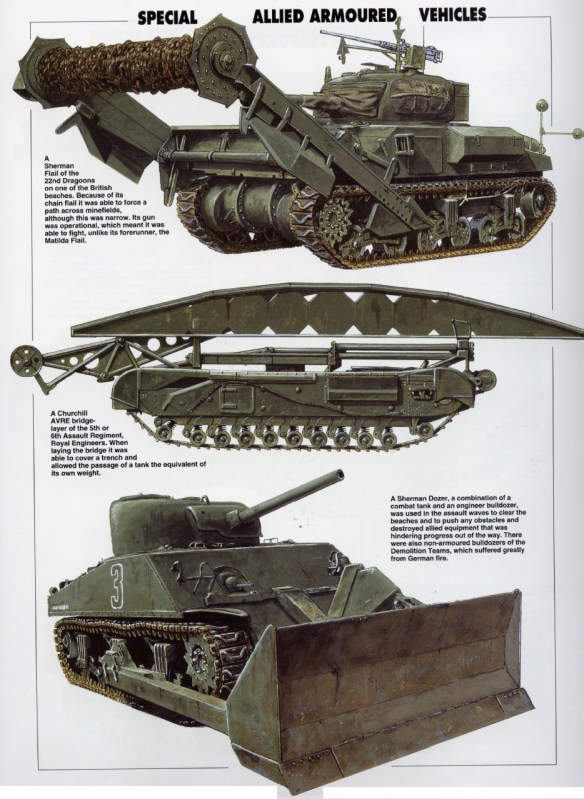The reasons for the choice of Churchills for this role were the heavy armour, roomy interior, and obvious adaptability of the hull. Standardised external fittings rendered the A VRE suitable for employment in a variety of roles, such as fascine carrier, small box-girder bridgelayers, mat layers, and for towing armoured sledges.
The Petard mortar with which the specially designed turret was fitted, was loaded at the muzzle by means of a sliding hatch above what normally would be the hull-gunner’s seat in a gun tank. The 290mm bomb weighed 40lb, was known as ‘General Wade’s Flying Dustbin’, and was usually visible for most of its flight. A more powerful version of the Petard, which fired a dummy projectile to the rear whilst the real bomb left the muzzle, so giving a recoilless effect, was fitted to a prototype A VRE known as Ardeer Aggie, but did not go into production.
The obstacles facing the Allies along Hitler’s West Wall consisted of:
1 Underwater obstacles, principally
(a) Element ‘C’, a gate-like structure of girders
(b) Czechoslovakian Hedgehogs-a tetrahedron of girders.
2 On the Beach itself
(a) Mines
(b) Soft clay or sand.
3 Behind the Beach
(a) Sea-wall, and/or
(b) Anti-tank ditch
(c) Concrete emplacements, bunkers etc of all types
To combat these, 79th Armoured Division had devised the following vehicles:
1 The Crab. A flail mounted on a Sherman gun tank.
2 The Armoured Vehicle Royal Engineers (AVRE), a Churchill fitted with a special turret mounting a 290mm Petard Mortar, and which could be used III many roles, amongst them fascine carrier, bridgelayer, and bobbin carrier.
3 Armoured Bulldozer.
There was to be no repetition of the infantry being pinned down on the beach, as they had been at Dieppe ; in fact the first soldiers ashore would be riding in amphibious Duplex-Drive Shermans, halting at the water’s edge and suppressing the defenders’ fire. Next would come the breaching teams, landing from LCTs, and consisting of Crabs and AVREs. The Crabs would flail a path in echelon through the beach minefield. Those vehicles not actually flailing would supplement the fire of the DDs, whilst the AVREs smashed the Element ‘C’ and the Hedgehogs, or laid carpets across sticky blue mud from bobbins. When the flailed path had reached the sea-wall, a small box girder (SBG) AVRE would proceed up it and lay its bridge on to the top, and a second A VRE would clamber across to drop a fascine into the anti-tank ditch beyond.
The DDs and Crabs could now leave the beach and take the part of conventional gun-tanks. Obstinate strongpoints still firing would receive the shattering benefit of a 40lb ‘flying dustbin’ bomb from an AVRE.
#
One of the most spectacular feats of D-Day was performed by 79 Squadron. The AVREs had rallied at mid-day, but at 15.00hrs the Squadron received a call for help from the officer commanding No 4 Commando, which was held up by determined resistance in the town of Ouistreham.
Collecting ten AVREs, Major J. G. Hanson set off for the town, and in an hour-long action subjected the enemy to a terrifying rain of murderous ‘flying dustbins’, smashing buildings around their defenders with a ferocious simplicity. The squadron reached the important lock gates of the Caen canal before the enemy could blow their demolition charges, which were rendered harmless.
In a situation such as this, where close fighting in built-up areas was taking place, there is no doubt that the AVREs caused more damage than lay in the capacity of conventional gun-tanks. Some commanders draw the wrong conclusions from this sort of engagement, and seeing only the damage caused by the Petard, attempted to use the AVREs as gun-tanks, a role which they could not perform in view of the limited range of the weapon. This sometimes led to the loss of vehicles and crews as AVREs gallantly strove to close the range to practicable limits under the eyes of enemy anti-tank guns.
